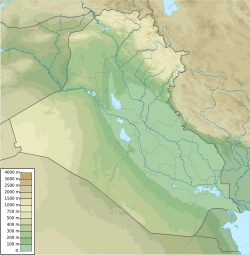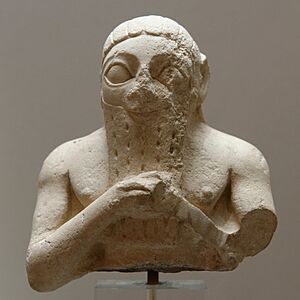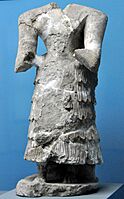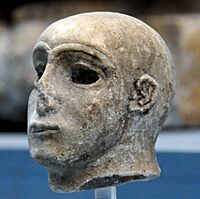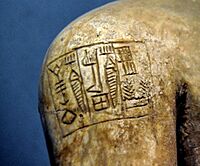Adab (city) facts for kids
|
Adab, Udab
|
|
| Alternative name | Bismya |
|---|---|
| Location | Wasit Province, Iraq |
| Region | Mesopotamia |
| Coordinates | 31°56′49″N 45°58′8″E / 31.94694°N 45.96889°E |
| Type | tell |
| Site notes | |
| Excavation dates | 1885, 1890, 1902, 1903–1904 |
| Archaeologists | W.H. Ward, J.P. Peters, W. Andrae, E.J. Banks |
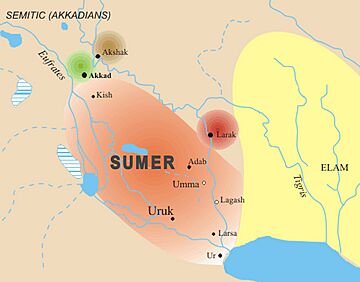
Adab or Udab was an ancient Sumerian city. It was located between the important cities of Girsu and Nippur. Today, its ruins are found at a place called Bismaya or Bismya in the Wasit Province of Iraq. The people of Adab believed their city was protected by a special god named Parag'ellilegarra.
Contents
Exploring Ancient Adab: Archaeology
The ancient city of Adab covers a large area, about 400 hectares. This is like 400 football fields! The site is made up of several low hills, or tells, which are mounds formed over centuries by layers of old buildings and trash. These mounds are about 12 meters high. Adab is located closer to the Tigris River than the Euphrates River.
Early Discoveries at Bismaya
People first started looking into the Bismaya site in the late 1800s. William Hayes Ward visited in 1885, and John Punnett Peters from the University of Pennsylvania came in 1890. Both spent only a day there. They found a few pieces of cuneiform writing, which is an ancient way of writing using wedge-shaped marks. In 1902, Walter Andrae also visited and made a simple map of the area.
The University of Chicago Excavations
The most important digs happened between 1903 and 1905. The University of Chicago sent Edgar James Banks to lead the work. These excavations showed that the mounds were indeed the ancient city of Adab. Before this, Adab was only known from old lists of Sumerian kings and a short mention in the famous Hammurabi Code.
Banks discovered that a canal divided the city into two parts. On an island in this canal stood the city's main temple, called E-mach. This temple had a ziggurat, which is a large stepped tower. Adab was clearly a very important city long ago. However, it was abandoned quite early in history.
What Archaeologists Found
The ruins closest to the surface belonged to kings like Shulgi and Ur-Nammu. They ruled around 2000 BC during the Third Dynasty of Ur. Below these, archaeologists found items from even older times, around 2300 BC. These included things from the reigns of Naram-Suen and Sargon of Akkad. Even deeper, there were 10.5 meters of older layers, showing the city was occupied for a very long time.
Besides buildings, walls, and graves, Banks found many clay tablets with ancient writing. These tablets are like ancient books or records. He also found tools made of bronze and stone.
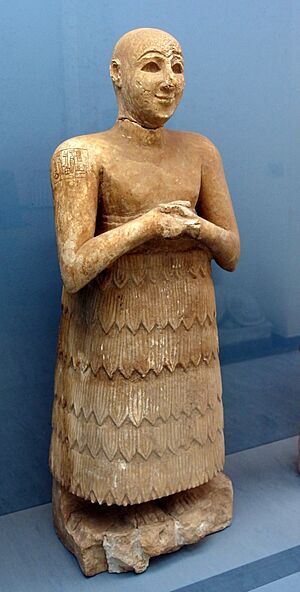
Many of the clay tablets went to the Oriental Institute, Chicago and the Istanbul Museum. These tablets tell us a lot about daily life and history in Adab. One of the most exciting finds was a complete statue made of white marble. It's thought to be one of the oldest statues ever found in Mesopotamia. This statue, now in the Istanbul Archaeology Museums, is of a ruler named Lugal-dalu. Another important discovery was a pile of broken pieces from the temple. These fragments were from beautiful vases made of marble, alabaster, and other precious stones. Some even had carvings and were decorated with ivory and jewels.
Recent Surveys and Challenges
Sadly, much of the Adab site has been damaged by people illegally digging for artifacts. Because of this, it's hard for archaeologists to do more official digs. However, from 2016 to 2019, the University of Bologna and Iraqi experts used special tools to study the site from above. They created a map of the ancient city's layout and its water systems. They found a previously unknown palace and confirmed that canals surrounded the city. They also discovered a large central harbor connected to the Tigris River.
Adab's Long History
Adab was an important city for a very long time, starting from at least the Early Dynastic Period.
Early Dynastic Period (around 2900-2350 BC)
During this early time, Adab had a temple dedicated to the goddess Inanna called E-shar. Ancient texts mention that kings from other cities, like Mesilim of Kish, might have ruled Adab at times. One of Adab's own kings, Lugal-Anne-Mundu, is mentioned in the Sumerian King List. Some later writings claim he built a huge empire stretching far across the ancient world. Adab was also a trading partner with Ebla, a powerful city in northern Syria.
Sargonic Period (around 2350-2150 BC)
Later, Adab came under the control of the Akkadian Empire. A governor named Meskigal, who first served a king from Uruk, switched his loyalty to Sargon of Akkad. He later joined a big rebellion against Sargon's grandson, Naram-Sin, but was defeated. After this, Adab was directly ruled by Akkadian governors. By the end of the Akkadian period, a group called the Gutians took over Adab and made it their capital for a while.
Adab continued to have governors under the Ur III dynasty (around 2100-2000 BC). Even though archaeologists haven't found much from later periods at Bismaya, Adab is still mentioned in texts like the Code of Hammurabi, showing it remained known.
Gallery
-
Seal of "Urdumu, Ensi of Udnunki" ("Urdumu, Governor of Adab")
-
UD-NUN-KI, "City of Adab" on the statue of Lugal-dalu, with rendering in early Sumero-Akkadian cuneiform.
See also


